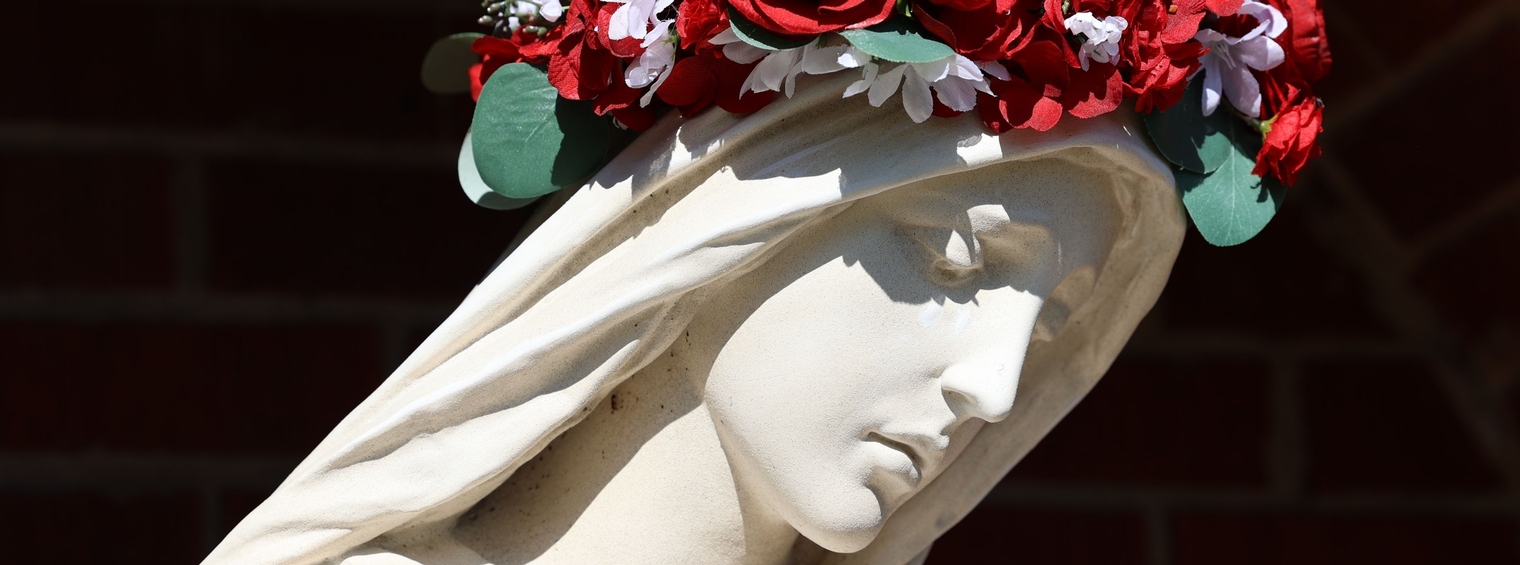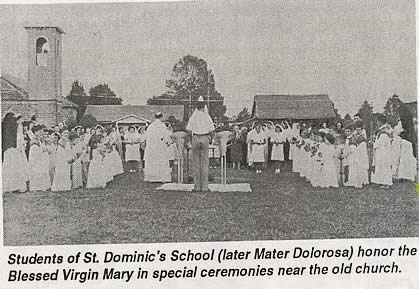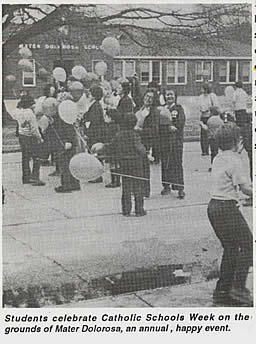

Mater Dolorosa Catholic School
founded in 1921
.png)
Picture taken in 1960's
.png)
Picture taken in 2011
our history
The story of our school begins in Independence, Louisiana just over a century ago. Back then, no church, rectory, convent, or school existed in the small town, and the Catholic Church had a very limited presence. However, this changed as large numbers of Italian immigrants arrived in Central Tangipahoa Parish and joined local farmers and lumbermen who had settled in the area several decades before. The hard-working immigrants carried with them a conviction in their Catholic faith, which had been a cherished part of their lives in Italy. Around the turn of the century, the parish of Mater Dolorosa was officially founded by Fr. Columban Wenzel, a benediction. The first pastor, Fr. Placido Gabrielli, arrived in 1908. Fr. Gabrielli faced incredible challenges, one of the largest being the absence of a church – The original wooden church had been destroyed by the famous hurricane of 1907. Despite these difficulties, the parish flourished, and by the early 1920s, the need for a Catholic school in the community had become apparent. Fortunately, the great Dominican order had assumed the shepherd's staff for the flock of Mater Dolorosa and were leading the parish in the proper direction.
 In the spring of 1921, Spanish-Dominican Fr. John Ayuela was pastor of Mater Dolorosa. Father Ayuela contracted with the Dominican Sisters of St. Mary's in New Orleans to start a school. Sister Mary deRicci Hutchinson, the prioress of St. Mary's, sent Sister Mary Margaret Sustendal, O.P. to Independence, to “find out what was needed.” Upon her return, Sister Mary Margaret reported tersely, "EVERYTHING!” The sisters, on their arrival, found a house and three beds. Joining Sister Mary Margaret on the educational mission were Sister Mary Albert Sporl, cook and housekeeper, Sister Mary Sebastian, a young sister in failing health, and Sister Mary Berchmans Shanks, who shared the teaching duties with Sister Mary Margaret. The sisters were to be paid $30 a month and held the privilege of selling school books, stationary and first communion supplies to the pupils.
In the spring of 1921, Spanish-Dominican Fr. John Ayuela was pastor of Mater Dolorosa. Father Ayuela contracted with the Dominican Sisters of St. Mary's in New Orleans to start a school. Sister Mary deRicci Hutchinson, the prioress of St. Mary's, sent Sister Mary Margaret Sustendal, O.P. to Independence, to “find out what was needed.” Upon her return, Sister Mary Margaret reported tersely, "EVERYTHING!” The sisters, on their arrival, found a house and three beds. Joining Sister Mary Margaret on the educational mission were Sister Mary Albert Sporl, cook and housekeeper, Sister Mary Sebastian, a young sister in failing health, and Sister Mary Berchmans Shanks, who shared the teaching duties with Sister Mary Margaret. The sisters were to be paid $30 a month and held the privilege of selling school books, stationary and first communion supplies to the pupils.
The sisters worked hard, and by July, the school was ready for opening. (Note that school started in July then, so that the term could be completed very early in the spring, allowing the children to work in the many strawberry fields in the area.) The school was properly dedicated and named St. Dominic's in honor of the great founder of the Dominican order. The school officially commenced on Sister Mary Margaret's birthday, July 11, 1921. The school's future was entrusted to the special care of Father John and his assistant pastor, Father Joaquin Fortea. That early school house, which stood where today's Family Life Center (Convent) is located, certainly did not resemble today's building. Parish records describe the school as two raised rooms above a basement – an unusual feature for a building in damp Southern Louisiana. For the first term, the two schoolrooms sat on the ground, and not for another month did the basement come into existence.
.png) The school began with the attendance of 240 boys and girls enrolled in grades one through four. Two of the school's earliest pupils were Frances and Felecie Anzalone. Because the pupils' desks had yet to arrive, only the teacher had the luxury of using one. Sister Mary Margaret taught third and fourth grades in the front room, while Sister Margaret Berchmans taught the primer, first, and second grades in the other room. As time went on, it became apparent that the school would need to expand in order to comfortably house the number of students in attendance. Therefore, classes were held in the church while construction took place on the building. When the school was finished, the first lay teacher, Miss Mona Fox of New Orleans, was hired to teach the primer grades. Countless excellent lay teachers have since served the school extremely well and continue to do so today.
The school began with the attendance of 240 boys and girls enrolled in grades one through four. Two of the school's earliest pupils were Frances and Felecie Anzalone. Because the pupils' desks had yet to arrive, only the teacher had the luxury of using one. Sister Mary Margaret taught third and fourth grades in the front room, while Sister Margaret Berchmans taught the primer, first, and second grades in the other room. As time went on, it became apparent that the school would need to expand in order to comfortably house the number of students in attendance. Therefore, classes were held in the church while construction took place on the building. When the school was finished, the first lay teacher, Miss Mona Fox of New Orleans, was hired to teach the primer grades. Countless excellent lay teachers have since served the school extremely well and continue to do so today.
Unfortunately, the school would face difficulties in the coming years. The Great Depression, which affected the entire world, left its imprint here. Funds were not available to cover even the school's most basic needs. About 1933, the convent became dilapidated, and Father Fueye had no funds to repair it. True to their mission, the sisters pulled together the money needed to make the necessary repairs with the promise that the parish would eventually pay them back. Father Fueye wrote to the archbishop on September 5, 1933, about the lack of respect for the school in these poor times. Somehow, the school survived the dark days of the Great Depression and continued to serve the important need for Catholic Education in the area, but this would not be the end of its troubles. In 1937, severe drainage problems forced the sisters to leave temporarily and go back “to the city,” apparently New Orleans. Three years later, in 1940, the school had to be closed due to heavy ice.
The New Cucchiara Catholic Center
The years following World War II were prosperous, and by the late 1940s, the obvious need to replace the old school had become a paramount concern. Beginning in 1943, the acquisition of land where the school now sits was started. The City of Independence assisted in the efforts to build the new school by agreeing to close a street crossing the plot of land. Thus, the way was cleared, and construction began in 1948. The Cucchiara Center, which served functions, including the gymnasium, was dedicated in June of 1948.
.png)
.png)
Construction of The new school 
The new school was constructed for $78,000 and formally dedicated on December 10, 1949. The ceremonies were most impressive, with the memorable Bishop Joseph Francis Rummel leading the elaborate rituals. At this time, the school was renamed to more adequately reflect its special “place” in the community. The school would henceforth be known as Mater Dolorosa Elementary School, identifying the educational plant more closely with the church parish. Throughout the 1950s, 1960s, and 1970s, the school continued to grow and prosper.
For 100 years, Mater Dolorosa Catholic School has been at the heart of the Catholic community in Independence, LA. Its festivities have attracted students, alumni, teachers, former principals, faculty members, and parishioners from a number of different Catholic communities in Tangipahoa parish. From these beloved classrooms have come several generations of young scholars prepared for whatever challenges the world has held for them.
.png) In the 1970s, the founders of a new venture, the annual Little Italy Festival, began to create ties with Mater Dolorosa School. As it is now more properly named, the INDEPENDENCE ITALIAN FESTIVAL had its origins on Main Street near the Kluchin Building. It grew so rapidly that a new location was necessary. The school grounds seemed the logical place, and thus the festival was moved.
In the 1970s, the founders of a new venture, the annual Little Italy Festival, began to create ties with Mater Dolorosa School. As it is now more properly named, the INDEPENDENCE ITALIAN FESTIVAL had its origins on Main Street near the Kluchin Building. It grew so rapidly that a new location was necessary. The school grounds seemed the logical place, and thus the festival was moved.
Indeed, the founders of the festival, members of the Italian-American Cultural Association, played a large role in the construction of a new gymnasium. The Church also gave a most generous gift to start the construction of a new gym. The beautiful new gymnasium was constructed through the generosity of many parishioners of the community, under the leadership of then Pastor Isidore Vicenti, O.P., in a dedication ceremony on January 15, 1994. The gymnasium filled an obvious need in the school's facility and continues to serve the school and the parish today.
.png) For over five decades, the school has blossomed under the dedicated direction of the good Dominican Sisters of St. Mary, who came here so many years ago to pioneer Catholic education in the region. Mater Dolorosa has continued to flourish, even though the beloved sisters are no longer a presence. Dedicated “lay” principals and teachers are continuing a tradition as old as the school itself. They continue to give leadership to Catholic education in the Independence area. Since the last sisters left, lay principals have guided the school until the present.
For over five decades, the school has blossomed under the dedicated direction of the good Dominican Sisters of St. Mary, who came here so many years ago to pioneer Catholic education in the region. Mater Dolorosa has continued to flourish, even though the beloved sisters are no longer a presence. Dedicated “lay” principals and teachers are continuing a tradition as old as the school itself. They continue to give leadership to Catholic education in the Independence area. Since the last sisters left, lay principals have guided the school until the present.
This school is a lasting monument to the Catholic people and all Christians in this community. Since its inception, the Catholics of this area have demonstrated a willingness to sacrifice their time, talent, and resources to ensure the continuous availability of Catholic education. Through the collective efforts of parents, individuals, priests, sisters, and teachers, the community has steadfastly supported the belief that everyone should have the option of providing their children with a Catholic education.
Mater Dolorosa Catholic School stands as a profound testament of the generosity of the people of Central Tangipahoa Parish, who have placed a premium on Catholic education. Today, and every day, we commemorate the rich history of Mater Dolorosa Catholic School. With the ongoing grace of God's, it is our hope that the current students enrolled in the school will one day stand here to celebrate the school's significant milestones in the unforeseeable future.
.png)
MATER DOLOROSA CATHOLIC SCHOOL
Celebrating OVER 100 Years of Catholic Education
Be it known to all who enter here that CHRIST is the reason for this school.
He is the unseen but ever-present teacher in its classes.
He is the model of its faculty and the inspiration of its students.
